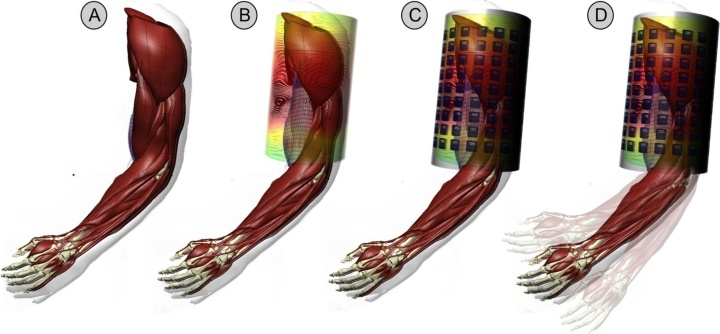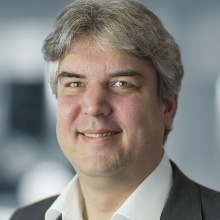In the latest tender round of the European Research Council (ERC), two scientists from the University of Stuttgart were each awarded one of the prestigious ERC Advanced Grants and will receive funding of up to almost EUR 3.5 million each for their respective projects: One is Prof. André Bächtiger, the first social scientist at the University of Stuttgart to be awarded an ERC grant. In his project “qMOTION”, Prof. Oliver Röhrle wants to use quantum technologies in order to decode neuromuscular control during movement. In addition to an ERC Proof-of-Concept Grant, this is the second ERC Advanced Grant (first was an ERC starting grant) he has received so far.
Prof. Wolfram Ressel, Rector at the University of Stuttgart, points out: “We are very pleased that within the first few months of this year, three important awards from the European Research Council have already gone to the University of Stuttgart, namely the two ERC Advanced Grants as well as an ERC Starting. My sincere congratulations to the scientists. The grants underpin the University of Stuttgart’s excellence in basic research across all disciplines and thus the University of Stuttgart’s position as a world-renowned research university. At the same time, the grants confirm the structure-forming developments of recent years in the Profile Areas ‘Quantum Technology’, ‘Simulation Science’ and Biomedical Systems as well as in the social sciences.”
Project qMOTION - Simulation-enhanced Highdensity Magneto-myographic Quantum Sensor Systems for Decoding Neuromuscular Control During - Prof. Oliver Röhrle
Muscles not only get living things in motion, but they can also be an interface between the brain and the environment. As such, they offer a glimpse into the brain, for example, in order to study how muscles are activated. If we were able to decode these neuromuscular signals, this would open up completely new possibilities in medical diagnostics and treatment as well as new methods for training and rehabilitation. However, this requires completely new approaches.
“We need, for example, new technologies that simultaneously capture information about recruitment patterns and the functional state of the muscle,” Prof. Oliver Röhrle explains, who is the Director of the Institute for Modeling and Simulation of Biomechanical Systems of the faculty as well as Principal Investigator in the Cluster of Excellence “Data-Integrated Simulation Science” (SimTech) at the University of Stuttgart. “This is the exact vision of qMOTION - which is about decoding, precisely and non-invasively, the neural activation of skeletal muscles using quantum sensors and data-driven simulation approaches.”

So far, the human neuromuscular system has been studied by measuring and processing the electric potential of the muscle. However, the disadvantage of this method is that the signal is “distorted” due to the electrical properties of the body, and it is difficult to identify and separate the up to 1000 sources of potential. Magnetic fields, by contrast, can penetrate biological tissue without changing their shape. To measure the magnetic field, however, highly sensitive magnetometers are required. These will be available for the first time thanks to the new quantum sensor technologies. Röhrle is convinced that “qMOTION is paving the way for a completely new field of research”.
In qMOTION, the researchers will be using magnetometers that are commercially available. Preliminary studies show that measuring the magnetic field is a promising option, especially when a so-called high-density magnetomyographic (HD-MMG) measuring system is available, i.e. a measuring system consisting of a grid-like array of up to 100 sensors. (see figures C and D).
The main objective of qMOTION is setting up a HD-MMG measuring system for the decoding of neuromuscular activity during movement. This is possible only because the HD-MMG data is also suitable for the development of novel functional imaging methods. Röhrle’s interdisciplinary curriculum vitae, with his research in the fields of applied mathematics and biomechanics, is an excellent basis for the project. In addition, the University of Stuttgart provides an ideal environment for this innovative research due to the SimTech Cluster of Excellence and the Cluster4Future “Quantum Sensors of the Future” (QSens).
About the ERC Advanced Grants
The projects and grants of the European Research Council are divided into categories: ERC Starting Grants, ERC Consolidator Grants, ERC Advanced Grants and ERC Synergy Grants. ERC Advanced Grants are among the most prestigious research awards worldwide and are aimed at established researchers with an outstanding academic performance. With Prof. Bächtiger and Prof. Röhrle, 12 ongoing ERC grants are now based at the University of Stuttgart, five of them are Advanced Grants.
| Contact | Prof. Oliver Röhrle, Ph. D., University of Stuttgart, IMSB, Pfaffenwaldring 5, 70569 Stuttgart, +49 711 685-66284, roehrle@simtech.uni-stuttgart.de |
|---|


